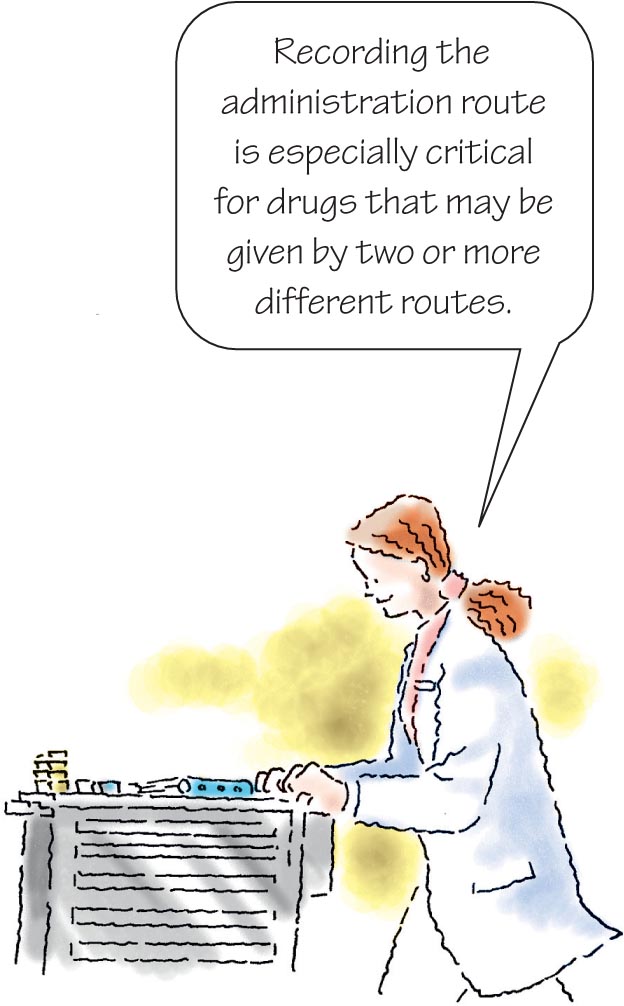In general, documentation reflects the tasks, assessments, and procedures nurses perform. Documenting on the administration record indicates that you've carried out the doctor's order.
Does that say subcutaneous or subcuticular?
Before transcribing the doctor's orders, make sure that they're complete, clear, and correct. If you detect a problem, contact the doctor before sending the order to the pharmacy. If you detect a problem after the order goes to the pharmacy, contact both the doctor and the pharmacy.
Is that 1 mg IV over 10 minutes or 10 mg over 1 minute?
Information recorded on an MAR must be written legibly in ink. Most facilities require the use of blue or black ink to allow for clear reproduction of the record. All hand written or computerized administration records must contain patient information, drug information, and signatures. Remember: Transcribing drug orders requires close attention because even a small discrepancy can cause a major drug error.
If your facility uses a computerized system, you don't need to transcribe patient information onto the administration record. It's already there because the admissions office or registration enters the patient information into the system, and the pharmacy adds information, such as the patient's height, weight, and allergies. In some systems, however, nurses may also enter this information.
If you use an MAR, stamp the form with the patient's admission data plate. If this isn't available, copy the information from the patient's identification bracelet.

Identification, please
Record the patient's full name, date of birth, hospital identification number, unit number, bed assignment, and allergies, even those that aren't drug related. If the patient doesn't have any known allergies, write “NKA.”
If the name of his insurance carrier is written on his identification bracelet, record this, too. Transcribe the information exactly as it appears on the bracelet. Make sure, of course, to confirm all of this information with the patient or power of attorney.
Next, transcribe from the doctor's order complete information about every drug the patient is taking. Include dates and drug names, dosages, strengths, dosage forms, administration routes, and administration times.
It's a date!
You must always record these dates on the administration record: the date the prescription was written; the date the drug should begin, if this is different from the original order date; and the date the drug should be discontinued.
At some facilities, the time and date the drug should begin are recorded together. This serves as a reference for the time to discontinue a drug when a limited period is indicated. Many facilities also have a stand ard length of time a drug may be given before it's automatically discontinued.

Full name, please
Record the drug's full generic name. If the doctor ordered the drug using a proprietary (trade or brand ) name, record this name as well. Don't use abbreviations, chemical symbols, research names, or special facility names. Doing so can cause medication errors or delay therapy.
Working on your strength
When recording drug strength, be sure to write the amount of the drug to be administered.
As a matter of form…
Also record the drug dosage form that the doctor ordered. Then decide whether the form is appropriate, considering the patient's special needs.
For example, if sustained-action theophylline tablets are ordered for a patient with a nasogastric tube, he won't be able to take the tablets orally. You'll have to crush them before administering them through the tube.
However, crushing sustained-action tablets destroys the drug's integrity and alters its therapeutic action. So, you'll need to contact the doctor and discuss an alternative drug dosage form.

Tracking the route
Recording the route of administration is especially critical for drugs that may be given by many different routes. For example, acetaminophen can be given orally, intravenously, or rectally. Other drugs can be given by only one correct route; for example, NPH insulin may be given subcutaneously but not IV.
Schedule scheme
The doctor's order should include an administration schedule, such as t.i.d. or q6h. Transcribe the schedule onto the administration record; then convert it into actual times based on your facility's policy and the drug's availability, characteristics, onset, and duration of action.
For example, t.i.d. may mean 9 a.m., 1 p.m., and 5 p.m. in one facility and 10 a.m., 2 p.m., and 6 p.m. in another. Similarly, b.i.d. may be 10 a.m. and 6 p.m. or 10 a.m. and 10 p.m. Sometimes the peak or onset of the medication can affect when you give it or how long to wait between doses. Check with the pharmacy and the doctor if needed.
Working round the clock
Remember that time notations are based on a 24-hour clock (see “Military time” in Chapter 7), unless otherwise specified. This means that the hour appearing first on a 24-hour clock should appear first in the time notation.
In other words, if an administration schedule is 2-10-2-10, the first 2 represents 2 a.m., or 0200 hours; the first 10 represents 10 a.m., or 1000 hours; the second 2 is 2 p.m., or 1400 hours; and the second 10 is 10 p.m., or 2200 hours.
Under special circumstances
Some facilities have separate administration records or specially designated areas of the regular administration record for transcribing single orders or special drug orders. Special orders include drugs given p.r.n., large volume parenteral drugs, and dermatologic and ophthalmic medications dispensed in bottles or tubes.
Other facilities put single orders or special drugs on the regular administration record. If this is the case where you work, be careful to distinguish these drugs from those that are regularly scheduled. All facilities have special forms for recording controlled substances. (See Controlling controlled substances.)

Don't forget to sign
Remember that every time you transcribe orders onto the administration record, you must sign it. First initial the record after transcribing from the doctor's order sheet. Many facilities also require the nurse to perform a chart check and initial the doctor's order sheet on a line after the last order. This indicates that all orders have been transcribed correctly onto the administration record. If someone other than the nurse transcribes the order, a nurse must co-sign the order sheet and the administration record.

After you give that drug, document!
Immediately after giving a drug, document the time of administration to prevent you from mistakenly giving the drug again. For scheduled drugs, you'll usually initial the appropriate time slot for the date that the drug is administered.
Scheduled drugs are considered on time if they're given within a half-hour or an hour of the ordered time. This can depend on the geographical area in which you practice. Regulations in the United States may change from state to state. For unscheduled drugs, such as single doses and p.r.n. drugs, record the exact time of administration in the appropriate slot.
If the dose you administer varies in any way from the strength or amount ordered, note this in a special area on the administration record or, if there isn't an administration record, in the progress notes. For example, you would document whether the patient refused to take a drug, consumed only part of a drug, or vomited shortly after taking a drug. Additionally, if a medication is refused, you should note the patient's reasoning, any education you provided, and when you notify the doctor.
Document detours
If you administer a drug by a different route from that which the doctor originally ordered, indicate that change, along with the reason and authorization for the change. Also document if a special administration technique, such as a Z-track IM injection, was used.
Citing the site
When administering a drug by a parenteral route, record the injection site to facilitate site rotation. Most administration forms include a numbered list of recognized sites, allowing you to record the site by its number. However, if necessary, describe anatomical land marks used to locate the specific site. Additionally, note the size of the needle used as well as how the patient tolerated the procedure.
When the timing's off
If you don't give a drug on time or if you miss a dose, document the reason on either the administration record or the patient's progress notes. Facility policy may require you to initial and circle the particular time missed on the administration record to draw attention to it. You must also notify the doctor as soon as possible and facilitate any orders consequently.
Initiate initialing
You need to sign the administration record after giving a drug. Put your initials in the appropriate space on the form. Make sure that they're legible and always sign them the same way. If another nurse on your unit has the same initials or name, use your middle initial to avoid confusion.
In addition, write your full name, title, and initials in the signature section of the administration record. This information must appear on every record you initial when administering drugs.
Here are some examples of administration record problems you may encounter in the real world.
The old NPO holdup
Your patient receives oral potassium chloride supplements. You're due to give a dose but the patient was made NPO for a test, so you withheld the dose. How do you record this?
In most facilities still using written charts, you record a withheld dose by placing your initials in the appropriate time slot on the MAR, and then circling them. You can dictate the reason you withheld the dose (in this case, the patient was made NPO) in the progress notes. Again, you should notify the doctor to ensure it is safe to withhold the dose.
In control
Your patient needs a dose of morphine sulfate, a controlled substance. You only need 2 mg of the 4-mg prefilled syringe available. On the record, how do you indicate that the extra morphine was appropriately discarded?
First, ask another nurse to watch as you appropriately discard the extra medication. Then, have her sign the controlled inventory record (or follow your facility's policy) to verify this process.